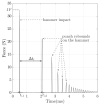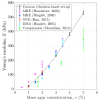Assessment of the Mechanical Properties of Soft Tissue Phantoms Using Impact Analysis
- PMID: 40096164
- PMCID: PMC11902684
- DOI: 10.3390/s25051344
Assessment of the Mechanical Properties of Soft Tissue Phantoms Using Impact Analysis
Abstract
Skin physiopathological conditions have a strong influence on its biomechanical properties. However, it remains difficult to accurately assess the surface stiffness of soft tissues. The aim of this study was to evaluate the performances of an impact-based analysis method (IBAM) and to compare them with those of an existing digital palpation device, MyotonPro®. The IBAM is based on the impact of an instrumented hammer equipped with a force sensor on a cylindrical punch in contact with agar-based phantoms mimicking soft tissues. The indicator Δt is estimated by analyzing the force signal obtained from the instrumented hammer. Various phantom geometries, stiffnesses and structures (homogeneous and bilayer) were used to estimate the performances of both methods. Measurements show that the IBAM is sensitive to a volume of interest equivalent to a sphere approximately twice the punch diameter. The sensitivity of the IBAM to changes in Young's modulus is similar to that of dynamic mechanical analysis (DMA) and significantly better compared to MyotonPro. The axial (respectively, lateral) resolution is two (respectively, five) times lower with the IBAM than with MyotonPro. The present study paves the way for the development of a simple, quantitative and non-invasive method to measure skin biomechanical properties.
Keywords: elastography; impact analysis; instrumentation; mechanical properties; soft tissues.
Conflict of interest statement
The authors declare no conflicts of interest.
Figures












References
-
- Shiina T., Nightingale K.R., Palmeri M.L., Hall T.J., Bamber J.C., Barr R.G., Castera L., Choi B.I., Chou Y.-H., Cosgrove D., et al. WFUMB Guidelines and Recommendations for Clinical Use of Ultrasound Elastography: Part 1: Basic Principles and Terminology. Ultrasound Med. Biol. 2015;41:1126–1147. doi: 10.1016/j.ultrasmedbio.2015.03.009. - DOI - PubMed
-
- Skovoroda A.R., Klishko A., Gusakyan D.A., Mayevskii Y.I., Yermilova V.D., Oranskaya G.A., Sarvazyan A. Quantitative analysis of the mechanical characteristics of pathologically changed soft biological tissues. Biophysics. 1995;40:1359–1364. - PubMed
MeSH terms
Grants and funding
LinkOut - more resources
Full Text Sources

